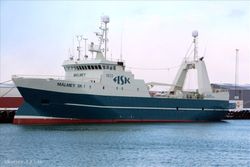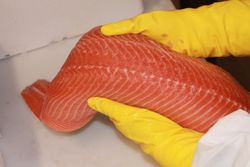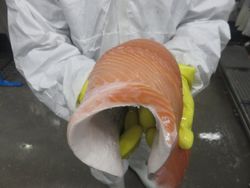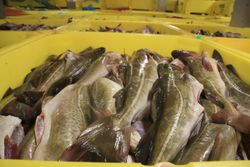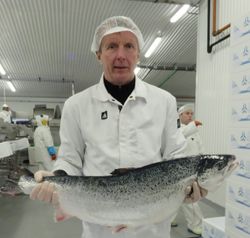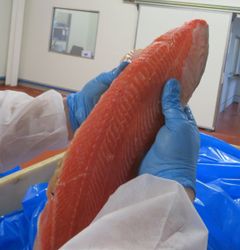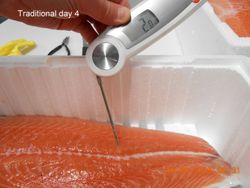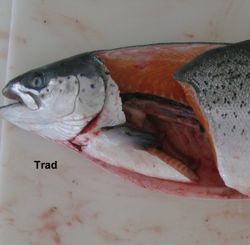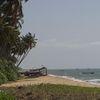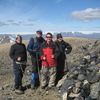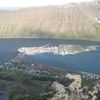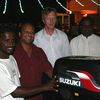27.4.2017 | 14:40
Grein į ensku um ofurkęlingarverkefniš
Introduction
The following article “Super-chilling Fish” was published in the Icelandic fisheries magazine Sjįvarafl on 18th of January 2017, the first issue of that year.[1] The title in original is: “Ofurkęling į fiski” or “Super-chilling Fish”. The author is Gunnar Žóršarson, consultant at Matķs, an Icelandic Food and Biotech R&D institute. Matķs is a government owned, independent and non-profit research company, founded in 2007.[2] Matķs write on their website: “We pursue research and development aligned to the food and biotechnology industries as well as providing Iceland’s leading analytical testing services for public and private authorities”.[3] More information can be found on Matķs’ website: www.matis.is.
The Sub-chilling project
The super-chilling project has been in development for some time; for the last few years, the food processing solution company Skaginn 3X , in collaboration with representatives from Fisk Seafood, have been considering the possibility of super-chilling whole whitefish. Later, the two companies collaborated with Matķs, a government owned research company in Iceland, on the subject. The aim was to investigate whether super-chilling was possible and what the effect would be on quality and production. Super-chilling means cooling a whole fish down to below zero degrees Celsius immediately after it has been caught/slaughtered; in traditional cooling methods the fish is chilled with ice to around 0-4 degrees Celsius.
The super-chilling method was first tested and used on pelagic fish, where the fish was cooled to below freezing point with no ice used neither during fishing nor in the production process. In the academic world the idea of super-chilling was not new and much research had been carried out, primarily in Norway, and mostly on salmon. The Norwegian research on salmon was mostly conducted in a lab where the environment was controlled, but showed positive results in connection with product quality and storage life. Skaginn 3X, in collaboration with Matķs, did experiments on super-chilling using blasts of cold air and fresh slush ice, which revealed a problem with surface freezing in the cooling system.
Additional experiments on super-chilling had been conducted by Skaginn 3X, in collaboration with Fisk Seafood in the town of Saušįrkrókur along with Iceprotein, an Icelandic biotech company.
The question that arose was whether it was possible to emulate the results of these experiments outside of the controlled conditions of the laboratory and if it was viable on an industrial scale. Furthermore, if it was possible to control the super-chilling process so it would be fast enough to prevent large ice crystals forming in the flesh of the fish, thus avoiding water loss in the product and a lower yield of fish. After considering the initial outcomes of the aforementioned research, Fisk Seafood decided to ask Skaginn 3X to develop a completely new and previously unknown method for cooling whitefish and use it aboard the fishing vessel Mįlmey SK 1.
Later, experiments were made with the cooling of haddock after rigor mortis. The purpose of the experiments was to explore the feasibility of exporting fresh fillets abroad. The super-chilled product was compared with traditionally cooled raw material, and the production process was monitored. The results showed that the super-chilled product had better fillet quality and a higher-value yield. The temperature during packaging was under zero degrees, without the fish being frozen, in contrast with higher temperatures customary in traditional fish production and cooling.
Repeated experiments gave similar results and in continuation, a wild cod was super-chilled right after it had been slaughtered, before rigor mortis. The fish was prepared in an isolated tub and was transported without ice to Fisk Seafood in Saušįrkrókur. In collaboration with the research company Iceprotein, the product was analysed and the fish compared to traditionally cooled raw material. Results were not clear enough and a need was felt for further research on the benefits of super-chilling. The next steps involved doing experiments on farmed salmon, and in August the same year a visit was made to Grieg Seafood in Alta, Norway and experiments conducted on farmed salmon. Results regarding super-chilling were positive, and the board of the company Grieg Seafood announced they wanted to take the research further and offered to provide funding for the project.
Other research on super-chilling
In theoretical terms, super-chilling means freezing 5-30% of the water content of the fish. Much research has been conducted on the subject and in short, the outcome is that super-chilling, with the right treatment, can improve the quality of the product considerably. When utilizing super-chilling, it is important to cool the product fast to reduce the risk of ice crystals forming within the fish, which can cause damage in the cellular structure of the flesh. The main rule is that smaller crystals cause less damage to the cellular structure of the flesh, whilst larger crystals can cause more damage. Crystals grow bigger when the chilling process is slower, and furthermore, instability during storage can also cause crystals to grow. Bigger crystals damage the walls of the muscle cells and the product loses some of its natural juice, which makes the texture of the fish chewy and dry – taste deteriorates and yield is reduced due to this water loss.
There is much to gain when utilizing super-chilling as it reduces the growth of microorganisms and development of enzymes, which in turn prolongs the lifetime of the product. Super-chilling reduces loss of water in the product during storage, increases fillet quality and makes filleting more efficient as the resulting firmer material is easier to handle. The researchers’ results on super-chilling showed that there was a great deal to gain. Using the fish itself as a refrigerant in the super-chilling process can improve the cold chain production of fresh fish considerably and therefore increase the quality of the fish on fresh fish markets. The main problem that arose was how to manage the production on an industrial scale, which would be more complicated than in the controlled environment of the laboratory.
During our research the aim was to freeze only 10-20% of the water content of the fish, to reduce the risk of freeze damage due to ice crystals.
The Super-chilling Project
The biggest problem the researchers faced with super-chilling was that the surface of the fish froze during the cooling process, which was carried out either with blasts of cold air or with fresh slush ice. When cooling through to the centre of the fish, the surface and the thinner part of the fish had a tendency to freeze, which in turn caused crystals to form in the flesh and therefore caused quality deterioration. This problem was overcome by using a new technique made possible with Skaginn 3X’s RoteX system whereby the fish is cooled in brine, which is in turn cooled by heat exchange.[5] At the freezing point, – which is slightly below zero degrees Celsius due to the fat content of the fish – phase transition takes place and excessive, latent heat needs to be removed from the fish to start the freezing process.
By entering the phase transition process, a considerable latent energy is formed in the fish, which in turn provides benefits during the storage of the fish and transportation to secondary producers or to the market. Super-chilling lowers the temperature of the fish below zero degrees in one or two hours while cooling with ice can take many hours.
Matķs, 3X Technology/Skaginn and Grieg Seafood received a research grant from Norske Forskningsradet to begin experiments utilizing super-chilling on salmon in collaboration with their client, the fish manufacturing company Hätälä in Finland. The project started in the beginning of 2015. Matķs, Skaginn 3X and Jakob Valgeir got a research grant from Atvest - The Economic Development Agency for the Westfjords region – in 2015 to develop super-chilling of cod onboard fishing vessels. The project reached a breakthrough when it won a grant from Nordic Innovation and Rannķs to develop the super-chilling concept further, to demonstrate the exceptional standard of the method and furthermore, to introduce it to the fishing industry and to fish farming companies.
A broad range of companies got together to develop the super-chilling method: research companies and fish industry companies involved in initial and further processing of salmon, as well as equipment producers. The following parties took part in the super-chilling project: Skaginn 3X, Matķs, Fisk Seafood, Iceprotein, Grieg Seafood, Hätälä Finland and Norway Seafood. The aim of the project was to develop a method that could increase the quality in the production of seafood and farmed fish products, especially on fresh fish markets.
In 2015 Matķs, Skaginn 3X, Arnarlax and Ķslandssaga collaborated to specifically study the effect super-chilling has on rigor mortis in cod and salmon. The collaboration was made possible with a grant from the AVS fund.
With the introduction of Mįlmey SK 1, an important step was taken in the development of super-chilling of whole fish, and in the beginning of 2016 the vessel Mįlmey SK 1 was equipped with state-of-the-art apparatus for super-chilling from Skaginn 3X.[6] An important milestone was reached when an entire catch was super-chilled[7] aboard ship at the point of slaughter, and kept under the right conditions until further handling down the production line, all without use of ice. Extensive research has been carried out on super-chilling in Saušįrkrókur, aboard Mįlmey, and in Reykjavķk, Ķsafjöršur, Bķldudal, Sušureyri, Norway, Finland and Denmark.
Research outcome
All research on the subject has now been concluded and a final report on the extensive super-chilling project is being made. Three reports on smaller projects have already been issued and are accessible on Matķs’s website.
Fillet quality
To determine the fillet quality in salmon, an approved Norwegian method was used, whereby the quality is measured from 0 (best) to 3-5 (worst). Fillet quality (taken from the same catch) was compared: on the one hand super-chilled raw material and on the other, raw material cooled in a traditional way.
A trained professional performed evaluation of the product three to seven days from slaughter. All results were in favor of the super-chilled product and the difference between the two methods was greater than expected. Image 4 shows a summary of the results where the elasticity of the fillets, firmness and gaping were compared. The tests, conducted in Finland and Japan, were very prominently in favor of super-chilling, and the biggest difference was seen in gaping, as shown in Image 4.
Results on super-chilling of cod were not as decisive, yet the results were generally in favor of super-chilling.
Rigor Mortis Stage
Research results showed considerable difference in contraction after rigor mortis on super-chilled fish when compared with traditionally cooled fish. Increased cooling slows down the contraction process and results in up to four times less contraction in the fish. Powerful contractions cause pulling between muscles and bones and can cause gaping in fillets. Fillet gaping is one of the biggest quality problems in fish fillet production, whether it is in seafood or salmon.
Simulators from Skaginn 3X in Ķsafjöršur were used to monitor and measure the production process as a function of time by filming the contractions and photographing the final results. Image 5 shows the difference in contraction between super-chilled cod and traditionally cooled with ice down to zero degrees, before filleting and rigor mortis.
Videos of the contractions have been put on YouTube and the web address is:
https://www.youtube.com/user/3XtechnologyIceland
Microorganisms and chemistry
A considerable difference is seen in microorganism growth, including spoilage bacteria, between the two groups in cod and salmon, demonstrating the advantage of the super-chilling method. This does not come as a surprise as the lower temperature reduces the activity of microorganisms and enzymes. This lengthens the lifespan of the product, which is very positive, especially when considering fresh fish. The difference can amount to an increase of up to three to four days in product lifespan, according to the research on super-chilling.
Water holding capacity
Measurements of the water holding capacity of the fish and water loss when storing are important quality variables when assessing the effects of super-chilling. If the cooling process is too slow and too deep, it can cause the formation of ice crystals that can damage fish muscle cells, reduce the water holding capacity and cause water loss in the fish. This in turn affects the quality as the fish muscle becomes tougher and drier by losing its natural juice.
Furthermore, there is potential financial loss if the fish loses weight. Research results in this area show that super-chilling, if correctly applied, increases the water holding capacity of the fish after a few days of storage. Water loss is reduced in a super-chilled product compared to traditionally cooled products as well as in products that have been thawed. Super-chilling projects on salmon show the same results, but the water holding capacity of cod was reduced during extended storage time, when compared to traditional raw material. It is important to keep in mind that stable storage temperature is necessary, as even a small deviation below the freezing point can cause the formation of large ice crystals.
Yield
According to research outcomes, the yield of super-chilled salmon is higher than that of traditionally cooled salmon. Less of a difference is seen in super-chilled cod, although its yield seems to be considerably higher compared to when it is traditionally cooled. Super-chilled fish is firmer, which in turn makes the fish more manageable to fillet and makes it easier to remove the skin. The problems associated with filleting soft fish are well-known, and deskinning through a skinning machine is also troublesome. On the other hand, it might become necessary to adapt processing machines to the super-chilled raw material, which will further increase the yield of the super-chilled products.
Production
The production of super-chilled salmon gave excellent results and many experiments have been conducted comparing it to traditional raw material in Finland and Denmark. Grieg Seafood super-chilled[8] up to ten tons of salmon in a RoteX spiral system, produced by Skaginn 3X, and transported it to Hätälä and to Norway Seafood. The production gave much fewer filleting failures than the traditional way of processing raw material and therefore less trimming was needed before packing. More muscle remained intact, as was noted in the chapter on fillet quality. The temperature of the packed salmon, after filleting, trimming, pin boning and slicing/portion cutting was under -1 °C. The salmon was transported in both EPS boxes and in 660-liter tubs. Super-chilled salmon was kept without ice for up to nine days before going into further production, and the super-chilled salmon showed consistently superior results where quality and production were concerned. In order to compare the effect of transportation on super-chilled and traditionally cooled products, two tubs of raw material processed according to the two methods were transported under the same controlled conditions.
The iced salmon was markedly wrinkled because of the ice in the tub, but this problem was absent in the transportation and storage of the ice-free super-chilled salmon.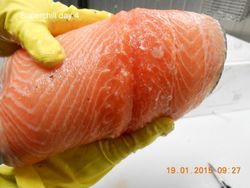
Mįlmey SK 1 has been using super-chilling[9] aboard for around two years and has landed 20 000 tons of fish during that time. No ice was used aboard, the fish was kept in the fish hold after being super-chilled in a RoteX tank and the fish hold was constantly kept under zero degrees. Fisk Seafood in Saušįrkrókur keeps the catch under the same conditions before it goes further into production as light-salted fish and as fresh fish for export. Aboard Mįlmey SK 1, there are three RoteX tanks that are all adjusted to different cooling times, in order to correctly and evenly cool the different sizes of fish. The system is completely automated, it categorises the fish into different tanks and into different temperatures. If ice were used aboard the vessel it would have to take around 5 tons of extra weight in each fishing trip. Being free of ice saves a lot of work aboard the vessel as icing fish in the fish hold is both a time-consuming and laborious job. As the RoteX solution aboard Mįlmey has been a success, new ships from HB Grandi will be equipped with the RoteX tanks and the automated fish holds, which will allow more time to bleed and gut the catch.
Arnarlax, a salmon production company located in Bķldudalur, has invested in Skaginn 3X’s RoteX bleeding and cooling system and are slaughtering up to 50 tons of salmon per day.
As customer reaction was positive, the company has reduced the amount of ice they put in the boxes and aim for a completely ice-free super-chilled product. The salmon is cooled to below zero degrees, which is crucial for quality and extended shelf life of the product. The difference between packing iced salmon at 4-6 °C, with the ice chilling the fish down to 0 °C in a few hours, and super-chilling it down below 0°C quickly, brings about unequivocal changes in product quality. The market has been open to the change and Arnarlax salmon is already a sought after product, sold at the highest prices while quality problem costs are at a minimum.
On the other hand, super-chilling is not yet a widely known nor accepted method, but as soon as the market accepts this new technique, Arnarlax can take the final step and dispense with all ice in its transportation.
Transportation, distribution and environmental effects
Iceless transportation of fresh fish opens up many exciting opportunities. Around 900.000 tons were transported by land from North Europe to markets in Central Europe in 2015 and around 237.000 tons were transported by air to Asia. To keep the raw material cool, approximately 132.000 tons of ice were used in trucking (6.600 trucks) and around 24.000 tons in flight to Asia (160 Boeing-747 Jumbo-Jet airplanes). The main problem with the transportation of iced salmon in tubs was the raw material being damaged by the pressure of the ice, but that problem is completely eliminated in iceless super-chilled products (see Image 7).
The transportation of iceless super-chilled raw material can enormously reduce the carbon footprint of the industry, when compared to traditional transportation that is in use at present.
During the super-chilling projects, iceless salmon was transported on a large scale from Finnmark in Norway to Finland and Denmark. Samples were sent by flight from Finnmark to Iceland, Japan and Dubai. Arnarlax exported super-chilled salmon to San Francisco with transit through New York. The results were excellent. In all cases the temperature was under zero degrees on reception of the product and quality was noticeably better than in traditionally cooled salmon that was also transported for comparison.
For decades the fishing industry has been using ice to keep raw material cold and to maintain quality in the supply chain. It is understandable that many feel skeptical when one-day ice as the best way to keep seafood fresh is abandoned and ice free cooling is promoted.
It is only natural that people are initially unconvinced about such revolutionary ideas and need time to think it over. Fisk Seafood showed remarkable foresight and courage when investing in Mįlmey SK 1, before it was possible to guarantee that the idea would work. No doubt this prescience has helped pave the way for the idea and it bodes well for the continuation of the project.
As has been mentioned above, for super-chilling to work the temperature of the process has to be controlled with great precision. Skaginn 3X’s contribution, by developing the equipment, was invaluable in this respect and made possible a technique that was not achievable a short while ago.[10] In many scientific articles the belief in the theory was strong yet concerns were expressed about how it would be applied on an industrial scale. Skaginn 3X have already made many business deals regarding their super-chilling[11] solutions, both for the seafood industry and for salmon farming. The project shows how the collaboration between different parties; universities and the scientific community, producers in the seafood and fish farming industries as well as mechanical manufacturers, can make a difference in creating better value in the fishing industry and produce the best result.
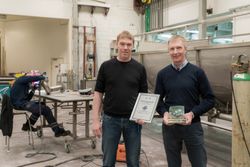 The most important result of these projects is the opportunity that has been created to make fresh fish more competitive on the market, both for wild and farmed fish. Fish is in competition with other food products, such as chicken, pizza and pork. According to consumers, one of the main problems concerning the sale of fish is the sometimes unpleasant fishy smell or taste. Bad smell or taste is connected to spoiled fish, which has been produced or stored in the incorrect way or under inadequate conditions. With the advent of super-chilling, incredible opportunities have arisen to make the supply chain more efficient, from slaughter to customer. The idea has to be presented to all parties within the supply chain so they can maximise the increase in quality of fresh fish on the market as well as increasing the value of the catch and of farmed fish.
The most important result of these projects is the opportunity that has been created to make fresh fish more competitive on the market, both for wild and farmed fish. Fish is in competition with other food products, such as chicken, pizza and pork. According to consumers, one of the main problems concerning the sale of fish is the sometimes unpleasant fishy smell or taste. Bad smell or taste is connected to spoiled fish, which has been produced or stored in the incorrect way or under inadequate conditions. With the advent of super-chilling, incredible opportunities have arisen to make the supply chain more efficient, from slaughter to customer. The idea has to be presented to all parties within the supply chain so they can maximise the increase in quality of fresh fish on the market as well as increasing the value of the catch and of farmed fish.
Stjórnmįl og samfélag | Breytt s.d. kl. 14:41 | Slóš | Facebook | Athugasemdir (0)
26.4.2017 | 13:09
Laxeldi į Vestfjöršum (Vesturland aprķl 2017)
Mikil įtök
Mikil įtök eiga sér staš vegna įforma um stórfellt laxeldi į Vestfjöršum, enda eru hagsmunir margir og misjafnir. Fyrir Vestfiršinga er mįliš stórt į alla męlikvarša og binda ķbśar miklar vonir viš aš eldisframleišslan geti snśiš vörn ķ sókn til framtķšar. Į sama tķma og Ķslendingum hefur fjölgaš umtalsvert sķšustu įratugina fękkar Vestfiršingum įrlega og ekkert lįt viršist vera į žeirri žróun. Helsta įstęša žessa er einhęft atvinnulķf og yngra fólk leitar ķ fjölmenniš til aš auka tękifęri sķn į vinnumarkaši. Sjįvarśtvegur er yfir helmingur af hagkerfi fjóršungsins og yfir 80% meš tengdum greinum. Eftirfarandi dęmi śtskżrir mikilvęgi žess aš renna fleiri stošum undir vestfirskt atvinnulķf: Vegna sjómannaverkfalls drógust śtsvarstekjur janśarmįnašar ķ Bolungarvķk saman um 25% en į sama tķma jukust žęr hjį Vesturbyggš um 9%. Engin vafi er į aš umsvif eldisfyrirtękja ķ vestanveršum fjóršungnum hafa dregiš śr mikilvęgi sjįvarśtvegs į svęšinu.
Miklir hagsmunir Vestfiršinga
Mišaš viš žį hagsmuni sem eru ķ hśfi er žaš sjįlfsögš krafa ķbśa Vestfjarša aš umręša um uppbyggingu laxeldis verši mįlefnaleg og byggš į rökum. Andstęšingar laxeldis verša aš gera sér grein fyrir žessum miklu hagsmunum og gera žarf kröfu til žeirra um aš halda umręšunni innan faglegra marka. Frį įrinu 1994 til 2011 fękkaši ķbśum į Bķldudal um 45% og um 16% ķ Ķsafjaršarbę. Frį upphafi laxeldis hefur žessi žróun snśist viš žar sem ķbśum ķ Vesturbyggš fjölgaši um 9% fram til 2015, en įfram fękkaši ķ Ķsafjaršarbę um 9%. Višsnśninginn į sunnanveršum Vestfjöršum mį rekja beint til uppbyggingar ķ laxeldi. Mišaš viš bjartsżnisspįr mį gera rįš fyrir aš nęstu fimm įrin verši allt aš žśsund manns aš vinna viš laxeldi ķ fjóršungnum og um 400 manns viš afleidd störf sem munu hafa mikil įhrif į veršmętasköpun og tekjur į Vestfjöršum.
Norskt laxeldi
Noršmenn framleiša um 1,3 milljónir tonna af laxi į įri og hefur framleišslan tķfaldast sķšan 1970 sem er vöxtur um 8% įri. Um 28 žśsund manns starfa viš greinina sem skilar um 640 milljöršum króna veršmęti įsamt um 320 milljöršum vegna afleiddrar starfsemi. Eldi er oršiš mikilvęgara en fiskveišar og vinnsla įsamt žvķ aš skila umtalsvert dżrari afurš į markaš. Nettó śtflutningsverš į laxi er um 800 kr/kg en ķ sjįvarśtvegi er veršiš innan viš 300 kr/kg. Ef ekki kęmi til vandamįl meš laxalśs er tališ aš framleišsla Noršmanna gęti veriš nokkrar milljónir tonna.
Laxeldi er hįtęknigrein sem krefst margskonar sérfręšinga, rįšgjafa, vķsinda- og tęknimanna. Ólķkt sjįvarśtvegi er mikiš um undirverktaka viš laxeldi, sem gefur mörgum tękifęri til aš stofna sitt eigiš fyrirtęki til aš takast į viš sérhęfš kefjandi störf. Greinin er žvķ hįtekjugrein og nśmer fimm ķ röšinni yfir hęstu laun į įrsverk ķ Noregi og skilar um 43 milljónum króna aš mešaltali į įri. Mešaltal atvinnugreina ķ Noregi eru 18 milljónir og til samanburšar skila fiskveišar 14 milljónum króna į įrsverk.
Įhęttustżring
Nżleg reglugerš ķ Noregi hefur gjörbreytt stöšu viš sleppingar śr eldiskvķum. En žó aš lög og reglur séu įgęt hjįlpartęki mun įrangur ašeins nįst meš vilja og athöfnum eldisfyrirtękjanna. Segja mį aš staša ķslenskra laxeldismanna sé einstök žar sem žeir standa ķ dag į nśllpunkti og geta nżtt sér reynslu Noršmanna sķšastlišna įratugi til aš byggja upp umhverfisvęnt laxeldi.
Skoša žarf alla viršiskešjuna og gera sér grein fyrir kröfum markašarins um sjįlfbęrni og umhverfismįl, frį hrognum aš fiski į diski neytandans. Ef ķslensk eldisfyrirtęki gera žetta ekki munu žau ekki lifa af ķ samkeppni į markaši. Fyrirtękin verša aš lķta į sleppingar sem alvarlegan umhverfisvanda sem getur haft įhrif į villta laxastofna. Sleppingar eru slęmar fyrir višskiptin og hafa mjög neikvęšar afleišingar į oršspor. Eldisfyrirtękin žurfa aš žekkja eldissvęšiš og vakta žaš meš reglubundnum hętti og naušsynlegt er aš gera įhęttumat fyrir eldissvęši og kvķar og vera višbśinn įföllum. Nota įhęttumat, eftirlit og ašgeršarįętlun! Eldi er flókiš fyrirbęri og žvķ fylgir įhętta en mikil tękifęri eru til aš takast į viš žį įhęttu og meš réttum ašferšum. Eldisfyrirtęki žrķfast ekki įn góšs oršspors og munu umhverfismįl, sjįlfbęrni og įbatasamt eldi fara saman hönd ķ hönd.
Laxeldi er umhverfisvęn matvęlaframleišsla
Eldi er naušsynlegt til aš framleiša prótein fyrir jaršarbśa og er mjög umhverfisvęn framleišsla ķ samanburši viš hefšbundin landbśnaš. Kolefnisspor laxeldis er einungis 2,9 kg/CO2 į hvert neysluhęft kķló, en t.d. eru žetta 30 kg/CO2 ķ nautakjötsframleišslu. Žaš žarf ašeins um 1,2 kg af fóšri fyrir lax til aš framleiša kķló af afurš, sem bżr viš žyngdarleysi, į mešan nautiš žarf um 10 kg. Ekkert plįss er fyrir stórfelda aukningu į hefšbundnum bśskap enda ręktunarsvęši takmarkaš. Eldi er hinsvegar stundaš ķ žrķvķdd og žarf žvķ miklu minna plįss.
Kynbętur og gelding
Kynbętur eldisfiska hafa aš mestu snśist um aš auka fóšurstušul og vaxtarhraša. Vaxtarhraši hefur tvöfaldast į sjö kynslóšum og ašeins žarf um 1,2 kg af fóšri til aš framleiša kķló af laxi. Upphaflega var hugmyndin meš geldingu aš seinka kynžroska og lękka kostnaš viš eldiš. Mikilvęgt er aš seinka kynžroska žar sem mikiš fóšur fer ķ framleišslu į kynfęrum ķ stašin fyrir vöšva. Hér į landi hefur veriš notast viš hįžrżsting viš hrognaframleišslu til aš draga śr kynžroska seinna į eldisferlinum. Krafa framķšarinnar veršur framleišsla į ófrjóum laxi til aš śtiloka erfšablöndun viš villta stofna og tryggja hagsmuni nįttśrunnar. Nżjustu ašferšir byggja į sameindaerfšafręši ķ laxakynbótum til aš framleiša geldlax ķ eldiskvķum. Menn binda miklar vonir viš sameindaerfšafręšilega ašferš (erfšamengja val) sem vonandi veršur til žess aš skapa meiri sįtt um laxeldi ķ framtķšinni.
Varnir gegn sjśkdómum
Meš auknu eldi eykst hętta į smitsjśkdómum ķ sjókvķum žar sem helstu įhrifažęttir eru žéttleiki ķ kvķum, umhverfisžęttir, mešhöndlun fisks og almennt heilbrigši. Almenn dżravelferš veršur ę fyrirferšameiri ķ umręšunni og er oršin rekstrarlegt fyrirbęri žar sem ekki nęst įrangur ķ eldi nema fiskinum lķši vel. Til aš draga śr smitdreifingu er fjarlęgšardreifing eldisstöšva mikilvęg en smitsjśkdómar berast venjulega ekki lengri vegalengd ķ sjó en 2-3 km en fjarlęgšarmörkin ķ dag į Vestfjöršum eru 5 km.
Tękifęri Vestfiršinga
Aš teknu tilliti til žess sem hér hefur veriš tępt į ętti laxeldi į Vestfjöršum aš vera vel innan įhęttumarka. Um mjög spennandi atvinnugrein er aš ręša sem gęti snśiš ķbśažróun į Vestfjöršum viš og gefiš okkur tękifęri til sóknar. Fiskišnašur er og veršur mikilvęgur ķ fjóršungnum en dugir ekki til aš laša aš ungt og vel menntaš fólk og bżšur ekki upp į žau tękifęri sem vestfirskar byggšir žurfa til aš blómstra. Feršažjónusta er vaxandi en mjög įrstķšarbundin į Vestfjöršum og hefur ekki bošiš upp į hįlaunastörf. Laxeldiš er einmitt žaš sem viš žurfum til aš snśa vörn ķ sókn.
„Transgourmet France“
26.4.2017 | 13:07
Leišar ķ Vesturlandi aprķl 2017
Borgarleg réttindi og lżšręši hefur alltaf veriš undirritušum hugfengiš og hefur litiš į žaš sem mikilvęgustu mįlefni stjórnmįlanna, enda forsenda hamingju og efnahag almennings. Žaš er ekki sjįlfgefiš aš žjóšir bśi viš žau skilyrši og žarf ekki aš lķta langt til aš sjį hörmungar ofrķkis, né fara langt ķ sögunni til aš minna okkur į ógnir einręšis. Bókin „Veröld sem var“ eftir Stefan Sweig ętti aš vera skyldulesning til aš minna okkur į hversu hratt heimurinn getur breyst til hins verra og ógnir alręšisins tekur viš. Žaš žarf stöšugt aš hlśa aš réttindum borgaranna og lżšręšis og berjast fyrir tilvist žeirra.
Žetta blaš er gefiš śt til aš upplżsa ķbśa Ķsafjaršarbęjar um hvernig meirihluti bęjarstjórnar trešur į réttindum minnihlutans, sem žó gętir hagsmuna meirihluta kosningabęrra manna. Įn žess aš bera starfshętti Ķ listans viš žęr ógnir sem vitnaš er til hér aš ofan, er rétt aš benda į aš mjór er sérhver vķsir og mikilvęgt aš hlśa aš lżšręši og viršingu fyrir minnihlutanum.
Eins og fram kemur ķ žeim greinum sem birtar eru ķ blašinu viršist meirihlutinn taka sér višhorf śtrįsarvķkings til fyrirmyndar „Ég į žetta og ég mį žetta“. Višhorfiš viršist vera hjį Ķ listanum aš žar sem žeir séu ķ meirihluta žurfi ekki aš taka tillit til minnihlutans. Ekki sé žörf į aš fara aš višurkenndum leikreglum aš mįl séu borin upp į bęjarstjórafundum, rędd žar sķšan sé gengiš frį žeim ķ sįtt įšur en mįlum er skilaš til embęttismanna til aš framkvęma žau. Žaš eru hinar lżšręšislegu leikreglur aš meirihluti rįši og ekkert viš žvķ aš segja.
Aš einhverju leyti er um žekkingarleysi fulltrśa meirihlutans aš ręša en oftar en ekki er um allgert tillitleysi og yfirgang aš ręša. Mįl sem hafa umtalsverš įhrif į stöšu bęjarsjóšs eru einfaldlega rędd ķ lokušum hópum og įn kynningar ķ bęjarstjórn eša bęjarrįši. Bęjarstjórinn hefur ķtrekaš sagst vera bęjarstjóri Ķ listans og bętt viš aš hann hafi mikil völd žar sem hann sé pólitķskt kosinn, sem er ķ meira lagi umhugsunarvert og nż skilgreining į skyldum ęšsta embęttismanns bęjarins.
Žaš er spurning hvort fyrirkomulag eins og Ķ listinn sem hefur meirihluta ķ bęjarstjórn sé góš lausn fyrir bęjarbśa? Engin žörf į aš ręša mįlin viš samstarfsflokk og ekkert bakland sem getur veitt ašhald. Gęti veriš aš fyrirferšamiklir einstaklingar taki völdin og rįši för? Svona lķtil śtgįfa af žvķ sem tępt er į hér ķ upphafi!
21.4.2017 | 07:58
Žróun sjįvarśtvegs į Ķslandi
Óįbyrg umręša
Neikvęš umręša um sjįvarśtveginn er stöšugt undrunarefni, sérstaklega ķ ljósi mikilvęgi atvinnugreinarinnar. Įlitsgjafar og višmęlendur fjölmišla byggja mįlflutning sinn oftar en ekki į vanžekkingu og meira į tilfinningum en rökhyggju. Enn og aftur er gripiš til uppnefna ķ umręšunni og talaš um „grįtkórinn“ žegar bent er į įhrif gengisstyrkingar į samkeppnishęfni ķslensks sjįvarśtvegs og talaš er um hótanir um aš flytja vinnsluna śr landi ef gengiš verši ekki lękkaš. Į mešan ķslenskur almenningur upplifir aukinn kaupmįtt og ódżrari utanlandsferšir vegna „hagstęšs gengis“er hin hlišin į peningnum aš helstu śtflutningsgreinar okkar sjįvarśtvegurinn og feršažjónustan eiga virkilega ķ vök aš verjast.
Erlend samkeppni
Ķ raun er ašeins veriš aš benda į žį stašreynd aš meš hękkun krónunnar aukast lķkurnar į aš fiskvinnslan flytjist śr landi, alla vega ef gengiš er śt frį žvķ aš ķslenskur sjįvarśtvegur sé rekinn į markašslegum forsendum. Hér er engin hótun į feršinni heldur ašeins bent į žį stašreynd aš fiskvinnsla veršur ekki rekin į landinu nema hśn standist samkeppni viš erlenda keppinauta. Ekki er langt sķšan óunninn gįmafiskur var fluttur til vinnslu ķ Evrópu ķ miklu magni, sem hefur nįnast veriš óžekkt undanfarin įr. Fullvinnsla hefur hinsveger aukist mikiš į Ķslandi undanfarin įr, bęši ķ bolfiski og uppsjįvarfiski. Ķslenskur sjįvarśtvegur hefur sżnt mikla ašlögunarhęfni og brugšist viš hękkun į innlendum kostnaši meš aukinni hagręšingu og tęknivęšingu.
„Sįtt“ um veišigjöld
Veišigjöld hafa jafnframt mikil įhrif į samkeppnishęfni og veriš bent į žaš ķ umręšunni aš žau auki samžjöppun ķ greininni, og žvķ hęrri sem žau eru munu fęrri og stęrri ašilar veiša og vinna fisk į Ķslandi. Stór fyrirtęki sem rįša yfir allri viršiskešjunni frį veišum til heildsölu munu einfaldlega yfirtaka smęrri fyrirtęki sem ekki hafa borš fyrir bįru til aš standa undir ķžyngjandi skattlagningu. Žetta er ķ sjįlfu sér ekki alvont žar sem žaš eykur framleišni og veršmętasköpun en rétt aš menn geri sér grein fyrir žessu og lįti žaš ekki koma sér į óvart žegar žaš raungerist. Séu žį meš įętlun um hvernig bregšast eigi viš t.d. byggšaröskun sem óumflżjanlega fylgir slķku róti ķ atvinnugreininni. Žaš veldur vonbrigšum aš heyra sjįvarśtvegsrįšherra hóta hękkun į veišigjöldum til aš neyša sjįvarśtveginn til aš uppfylla; žaš sem honum finnst vera samfélagsleg įbyrgš. Žaš er mikilvęgt aš rįšamenn geri sér grein fyrir įhrifum veišigjalda og hękkun į žeim veršur varla gerš ķ sįtt viš atvinnugreinina.
Tęknivęšing
Meš aukinni tęknivęšingu og sjįlfvirkni er óumflżjanlegt aš fękka žarf vinnsluhśsum og fęrri munu starfa viš greinina ķ framtķšinni. Žvķ fylgja nżjar įskoranir og nż tękifęri sem geta enn aukiš į veršmętasköpun ķ greininni, eins og gerst hefur ķ uppsjįvarvinnslu okkar Ķslendinga. Einn fylgifiskur aukinnar tęknivęšingar er meiri žörf į fjįrmagni til aš standa undir stórauknum fjįrfestingum ķ greininni. Žetta viršist oft gleymast žegar įlitsgjafar fjandskapast śt ķ aršgreišslur fyrirtękja, en enginn mun fjįrfesta ķ žessari grein frekar en ķ annari įn žess aš reikna meš įvöxtun žeirra fjįrmuna til framtķšar.
Hvaš er samfélagsleg įbyrgš?
Samfélagsleg įbyrgš fyrirtękja getur varla byggst į žvķ śr hvaša Keflavķkinni er róiš og jafn sįrt er aš loka vinnustaš ķ Reykjavķk og į Akranesi. Meš nżrri tękni eins og vatnskuršarvélum og žjörkum aukast afköst į manntķma og žannig mun starfssmönnum og vinnsluhśsum fękka. Slķkri žróun geta žó fylgt mikil tękifęri žar sem ķ staš erfišisvinnu verša til betur launuš tęknistörf. Žaš ętti aš vera forgangsmįl hjį sveitarfélögum og launžegahreyfingunni aš taka žįtt ķ slķkum breytingum meš sjįvarśtvegsfyrirtękjum og tryggja hlutdeild starfsmanna ķ aukinni framleišni ķ framtķšinni. Žaš er hin raunverulega samfélagslega įbyrgš aš fyrirtęki, starfsmenn og samfélög leggist į eitt til aš višhalda samkeppnishęfni og veršmętasköpun ķ ķslenskum sjįvarśtveg til framtķšar. Aš taka žįtt ķ žróuninni og hafa įhrif hana į jįkvęšan hįtt er einmitt samfélagsleg įbyrgš.
Um bloggiš
Gunnar Þórðarson
Tenglar
Hallgrķmur blįskór 2012
- Gengiðr úr Hornvík í Kjaransvík
- Kjaransvík - Sæból
- GEngið á Ryt og Darra
- Gengið á Straumnesfjall
- Gengið á brúnir Grænuhlíðar
Smölun ķ Austurdal
- Austurdalur -2010 Dagur 1 Smölun ķ hinum ęgifargra Austurdal sušur af Skagafirši
- Austurdalur - 2010 Dagur 2 Annar dagur smalamensku ķ Austurdal ķ Skagafirši
- Austurdalur -2010 Dagur 3 Lokadagur smölunar fyrir Austudalsfélagiš ķ Skagafirši
- Föstudagur 2011 Smalaferš Göngumannafélags Austurdals ķ september 2011
- Laugardagur í Austurdal 2011 Smalaferš Göngumannafélags Austurdals ķ september 2011
- Sunnurdagur í Austurdal - 2011 Smalaferš Göngumannafélags Austurdals ķ september 2011
- Mánudagur 2011 Smalaferš Göngumannafélags Austurdals ķ september 2011
Skśtukaupin 1976
Viš félagarir, undirritaršu, Jón Grķmsson og Hjalti Žróršarson keyptum skśtu ķ Bretlandi og sigldum henni heim til Ķslands
- Kafli 1 - Skútukaupin undirbúin
- Kafli 2 - England
- Kafli 3 - lagt í siglinguna miklu
- Kafli 4 - Captain Thordarson
- Kafli 5 - Siglt í norður
- Kafli 6 - Færeyjar - Ísland
- Kafli 7 - Siglt til Ísafjarðar
Ķsrael 1974
Sagt frį ęvintżri okkar Stķnu, Nonna Grķms og Hjalta Bróšur žegar viš ókum yfir Evrópu 1974. Fórum frį Aženu til ķsrael og unnum žar į samyrkjubśi.
- Kafli 1 - Mótorhjólagengið
- Kafli 2 - Júgóslavía, Grikkland og Ísrael
- Kafli 3 - Á kibbutz undir Gólanhæðum
- Kafli 4 - Í kjölfar árásarinnar
- Kafli 6 - Maðurinn með ljáinn
- Kafli 5 - Endurfundir
- Kafli 7 - Frá rauðu ljósi í Milanó
- Kafli 8 - Fjölskyldu og varnarmál
- Kafli 9 - Vinna í Elat
- Kafli 10 - Daglegt líf á Shamir
- Kafli 11 - Til Grikklands
- Kafli 12 - Sögulok í London
Aš Fjallabaki 2012
Sušur um höfin 1979
Frį feršalagi okkar Stķnu į seglskśtunni Bonny frį Ķsafirši til Mallorca ķ Mišjaršarhafi
Sigling frį Mallorka til Grikklands
- Kafli 1 - lagt af stað til Ítalíu Fimm félagar sigldu Bonny frį Spįnar til Grikklands
- Kafli 2 - Sikiley og Grikkland
- Kafli 3 - Kea og Paros
- Kafli 4 - Santorini
Safarķferš ķ Śganda
- Ferð til Murchison Falls - fyrri hluti Safarķferš inn ķ frumskóg Śganda
- Ferð til Murchison Falls - seinni hluti
Hįlendisferš 2010
- Gengið á Fimmvörðuháls Eldstöšvar Fimmvöršuhįls skošašar
- Skaftafell og Kristínartindar Gengiš į Kristķnartinda
- Gengið á Mælifell Ekiš Fjallabak syšra noršur fyrir Mżrdalsjökul
- Friðland að Fjallabaki Gengiš um viš Landmannalaugar
- Gengið á Löðmund Gengiš į Löšmund viš Dómadal
- Gengið á Snæfell Gengiš į hęsta fjall Ķslands utan jökla, Snęfell
- Gengið í Geldingarfell Ferš um Lónsöręvi meš frįbęrum hópi, sumariš 2010
- Gengið í Egilssel Gengiš śr Geldingafelli ķ Egilssel viš Lónsöręfi
- Gengið niður Lónsöræfi Žriggja daga göngu noršan og austan Vatnajökuls lokiš
Sri Lanka 2007
- Sri Lanka 2006-2008 Starfaš į Sri Lanka
Bloggvinir
-
 astromix
astromix
-
 ekg
ekg
-
 stefanbjarnason
stefanbjarnason
-
 golli
golli
-
 vikari
vikari
-
 gunnarpetur
gunnarpetur
-
 vestfirdir
vestfirdir
-
 gudni-is
gudni-is
-
 ea
ea
-
 ladyelin
ladyelin
-
 gp
gp
-
 altice
altice
-
 hjolaferd
hjolaferd
-
 kaffi
kaffi
-
 komediuleikhusid
komediuleikhusid
-
 rabelai
rabelai
-
 ziggi
ziggi
-
 huldumenn
huldumenn
-
 helgi-sigmunds
helgi-sigmunds
-
 sigrunzanz
sigrunzanz
-
 hordurhalldorsson
hordurhalldorsson
-
 baldher
baldher
-
 hjaltisig
hjaltisig
-
 lotta
lotta
-
 kjarri
kjarri
-
 bjarnimax
bjarnimax
-
 jovinsson
jovinsson
-
 smjattpatti
smjattpatti
-
 eirmor
eirmor
-
 vefritid
vefritid
-
 saemi7
saemi7
-
 siggisig
siggisig
-
 maggij
maggij
-
 lehamzdr
lehamzdr
-
 gauisig
gauisig
-
 jonvalurjensson
jonvalurjensson
-
 thjodarskutan
thjodarskutan
Heimsóknir
Flettingar
- Ķ dag (26.4.): 5
- Sl. sólarhring: 7
- Sl. viku: 49
- Frį upphafi: 283917
Annaš
- Innlit ķ dag: 5
- Innlit sl. viku: 43
- Gestir ķ dag: 5
- IP-tölur ķ dag: 5
Uppfęrt į 3 mķn. fresti.
Skżringar
